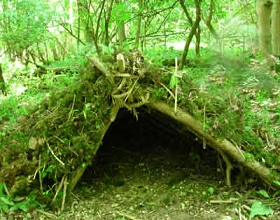Quick Look
Grade Level: 5
Time Required: 45 minutes
Expendable Cost/Group: US $5.30
Group Size: 3
Activity Dependency: None
Subject Areas: Earth and Space
NGSS Performance Expectations:

| 3-5-ETS1-3 |

Summary
In the continuing "Lost in the Amazon" scenario of this unit, students test the shelters they built in this unit's Lesson 3, Activity 1, for durability and water resistance.Engineering Connection
This lesson and activity provides an opportunity for student teams to complete the engineering design process used by practicing engineers, including constructing and testing their designs. See the related unit's Engineering Connection for further explanation.
Learning Objectives
Design and conduct a scientific experiment by testing model shelters for durability and water resistance.
Educational Standards
Each TeachEngineering lesson or activity is correlated to one or more K-12 science,
technology, engineering or math (STEM) educational standards.
All 100,000+ K-12 STEM standards covered in TeachEngineering are collected, maintained and packaged by the Achievement Standards Network (ASN),
a project of D2L (www.achievementstandards.org).
In the ASN, standards are hierarchically structured: first by source; e.g., by state; within source by type; e.g., science or mathematics;
within type by subtype, then by grade, etc.
Each TeachEngineering lesson or activity is correlated to one or more K-12 science, technology, engineering or math (STEM) educational standards.
All 100,000+ K-12 STEM standards covered in TeachEngineering are collected, maintained and packaged by the Achievement Standards Network (ASN), a project of D2L (www.achievementstandards.org).
In the ASN, standards are hierarchically structured: first by source; e.g., by state; within source by type; e.g., science or mathematics; within type by subtype, then by grade, etc.
NGSS: Next Generation Science Standards - Science
| NGSS Performance Expectation | ||
|---|---|---|
|
3-5-ETS1-3. Plan and carry out fair tests in which variables are controlled and failure points are considered to identify aspects of a model or prototype that can be improved. (Grades 3 - 5) Do you agree with this alignment? |
||
| Click to view other curriculum aligned to this Performance Expectation | ||
| This activity focuses on the following Three Dimensional Learning aspects of NGSS: | ||
| Science & Engineering Practices | Disciplinary Core Ideas | Crosscutting Concepts |
| Plan and conduct an investigation collaboratively to produce data to serve as the basis for evidence, using fair tests in which variables are controlled and the number of trials considered. Alignment agreement: | Tests are often designed to identify failure points or difficulties, which suggest the elements of the design that need to be improved. Alignment agreement: Different solutions need to be tested in order to determine which of them best solves the problem, given the criteria and the constraints.Alignment agreement: | |
International Technology and Engineering Educators Association - Technology
-
Test and evaluate the solutions for the design problem.
(Grades
3 -
5)
More Details
Do you agree with this alignment?
State Standards
Colorado - Science
-
Use tools to gather, view, analyze, and report results for scientific investigations about the relationships among mass, weight, volume, and density
(Grade
6)
More Details
Do you agree with this alignment?
-
Identify evidence that suggests there is a fundamental building block of matter
(Grade
6)
More Details
Do you agree with this alignment?
-
There are different forms of energy, and those forms of energy can be changed from one form to another – but total energy is conserved
(Grade
8)
More Details
Do you agree with this alignment?
Materials List
Per Group:
- 1 Dixie cup or small bowl (as used in Activity 1)
- 1 cake tray
- 1 watering can (or cup with holes poked in the bottom of it)
- 1 container with lid (such as a coffee can)
Worksheets and Attachments
Visit [www.teachengineering.org/activities/view/csm_lesson3_activity2_tg] to print or download.Introduction/Motivation
Will these shelters keep us dry in the rainforest? Will these shelters be sturdy enough to protect us? How can we test them to see if they are durable and rain resistant? (As guided by the worksheet, proceed to work together as a class to design an experiment to test the shelters.)
Procedure
- Discuss with students a good way to test the durability of the shelters.
- Give groups a time limit for setup in each step of testing their shelters.
Example Test
- After the shelters have been built, fold them.
- Put the folded shelters in a container (coffee can) and shake the container to simulate walking through the rainforest.
- Remove the shelter from the container and set it up on the cake tray with the Dixie cup inside.
- Using the watering can, pour water onto the shelter.
- Draw a line and number at the level of water on the cup. Measure the amount of water that ran into the cup and record this amount on a data sheet.
- Repeat steps 1-5 of this test five or six times to represent five or six nights.
Assessment
Worksheet: Have each group complete and hand in the worksheet. Review their answers to gauge their depth of comprehension.
Subscribe
Get the inside scoop on all things TeachEngineering such as new site features, curriculum updates, video releases, and more by signing up for our newsletter!More Curriculum Like This

As part of the continuing adventure scenario for this unit, students build shelters to protect themselves from the rain. After the shelters are built, the class performs durability and waterproof testing on the shelters.
Copyright
© 2013 by Regents of the University of Colorado; original © 2005 Colorado School of MinesSupporting Program
Adventure Engineering, Colorado School of MinesAcknowledgements
Adventure Engineering was supported by National Science Foundation grant nos. DUE 9950660 and GK-12 0086457. However, these contents do not necessarily represent the policies of the National Science Foundation, and you should not assume endorsement by the federal government.
Last modified: June 18, 2018







User Comments & Tips